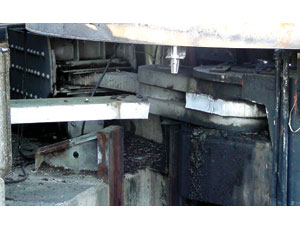For the second time in four months a 240-ton leaf of a main Ohio River miter-gate lock has failed, severely restricting shipping and signaling, once again, that it can be perilous to depend on aging infrastructure.


On Jan. 27, as the main-chamber, downstream gate of the Greenup Lock and Dam, near Greenup, Ky., neared closure, operators heard a pop and the landside leaf canted over, but it did not fall.
Mike Keathley, the U.S. Army Corps of Engineers project manager at the lock, which is slated for renovations, says a 5-in.-thick, 16-in.-wide steel anchor arm—one of two that tie the gudgeon-and-pin-style top hinge into the wall— sheared. The leaf was a few degrees from closure, so it dropped onto the sill, which gave it support and kept it from falling off the ball-and-socket joint at the bottom.
A similar leaf dropped completely off at another Ohio River lock on Sept. 27. Investigators say a solenoid that operates the valves to fill the lock failed in an open position, allowing water to flow in during an operation. The pressure forced the doors past their designed closure position, causing them to fail. Louisville District Commander Col. Keith Landry says the Corps has no history of a lock solenoid failing in an open position. Repairs to the leaves, scheduled for replacement later this year, are near completion.
Keathley, in the Huntington, W.Va. district, says fatigue in the 51-year-old arm may be to blame at Greenup. Two arms brace the gudgeon: A recess anchor arm takes the load when the gate is open, and a miter anchor arm, at right angles to the other, takes the load when the gate is closed. The load transfers as the leaf swings. “It’s not just age,” Keathley says. “Typically, a failure of this nature is associated with fatigue, where you have cyclic loading—high tension to relaxed to high tension.”
The arm recently was inspected visually. No cracks were detected, according to Keathley. Repairs will take six to eight weeks.


Post a comment to this article
Report Abusive Comment